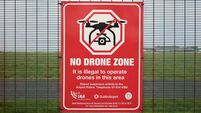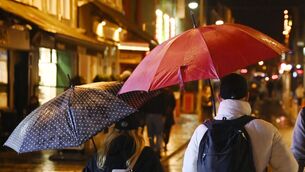Munster memories brought to life by Guinness

Stills from Munster’s famous victory over a touring All Blacks side have been converted into moving footage, including the stirring tackle by Seamus Dennison, centre, on New Zealand winger Stu Wilson, which set the tone for the game.
Munster rugby fans are again toasting one of the most historic performances in Irish sport — after Guinness advert-makers breathed new life into a great sporting occasion.
Many of the original images of Munster’s unforgettable win over the All Blacks in Thomond Park in 1978 have been generated into live action sequences in the brewer’s new television advert, which has brought back many great memories.
The photos were acquired after a six-month search through thousands of negatives hoarded by sports photographers in this country and in New Zealand.
RTÉ coverage of the game, the only contest the All Blacks lost on their tour of Britain and Ireland, was confined solely to images on 16mm cameras, as an outside broadcast unit with electronic cameras had been deployed to another event in Cork on the day.
With the aid of technology, Guinness recaptures some of the magical moments of the game, converting stills into video footage.
Even the All Blacks’ famed pre-match celebration, the haka, came alive — thanks to individual shots taken on the day.
And one of the great moments of the game, a Seamus Dennison tackle on flying All Black winger Stu Wilson, is given a new perspective.
Paul Dunkin, brand manger of Guinness Sport, said: “We had been interested in the Munster story of ’78 for a while — it’s a great David versus Goliath story and exemplifies Guinness’ brand strategy of ‘Made of More’ on a number of levels.
“Wherever possible, we wanted to use real footage and photographs of the game to make the film as authentic and moving as possible.
“The problem was that, in 1978, sports filming wasn’t what we’re used to today, with multiple cameras and close-ups and, before the advent of camera phones, few photographs of the match had existed.”
So a worldwide search begun for any photos taken during the game.
“We knew we would need to combine these with photographs of the game to get the close up of player’s faces we needed to capture the emotion of the game,” said Mr Dunkin. “We then planned on using a technique called 2D Parallax on these, literally cutting out and moving photographs to appear like slow-motion foot.”
The advert’s director, Dan Maslen, started the search in May.
“We started our hunt for any photographs in existence six months before the ad was due to go live and an enormous number of people helped us out along the way,” said Mr Dunkin.
“Cameras in 1978 were obviously not digital so, in order to check what photographs they had of the game, we spoke to photographers in Limerick who literally had to hunt down negatives in boxes in garages and storerooms to check if they had anything we would be able to use.
“One key person in our hunt for footage came not from Ireland but from New Zealand. He was Peter Bush, one of the country’s leading sports photographer who had been photographing All Blacks matches since 1949. Despite being aged 84, he spent hours tracking down and scanning in negatives for us, many of which were key shots in the film.”
But the lack of footage from that era is not a modern problem. Seamus Dennison, now a retired school teacher living in Roscrea, yesterday recalled the trouble the team had in looking up film on games the All Blacks played before coming to Limerick.
Seamus, 64, capped three times for Ireland, said: “Our coach, the great Tommy Kiernan, managed to get a video from a friend of his in England, a man named Busteed, which was played on a BBC rugby programme. The problem was when we were training in Limerick before the game, Tommy could not find a video machine to play the tape.
“But the night before the game, he located one at an industrial estate down the Dock Road in Limerick where they had a video player. The team went down to this industrial estate where we saw the video.
“Watching it, I noticed the All Blacks had a move where Stu Wilson would move in from the wing and cut through between the out-half and centre.
“I was in the centre with Greg Barrett. It was a very difficult move to defend. We decided if they tried the move I would take Wilson and Greg would take the man I was on. They tried it and I hit Stu Wilson and people are still talking about it 36 years on.
“I was down in my local in Roscrea, The Stand, having a pint when I saw the ad. It was great the way they put it all together in the ad. I never though people would be talking about the game all these years later.”












